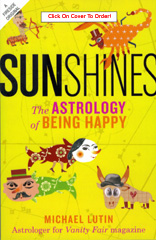|
Sunshines:
The Astrology Of Being Happy
by Michael Lutin,
Simon
and Schuster (Fireside Books), 2006.
Reviewed by John Townley
Ever
since the
newspapers of the 1940s both put astrology
on the popular map by reducing the Mother of Sciences to a birthday Sun
sign in
the general consciousness, both astrologers and publishers have been
trying to
find a way to break out of the oversimplified mold -- without going all
the way
back to the real thing, conceived of as just to horribly complex for
the simple
public moron to contend with, much less actually purchase a book on. In
the
meantime, the truly great astrologers of the 20th and 21st
who managed to make a fairly good living within the art did it by
writing
Sun-sign books or columns, some publicly, some surreptitiously. Charles
Jayne
wrote the column for the N.Y.
Daily News,
and Al H. Morrison the dailies for the N.Y.
Post, both entirely under the
table. Others like Carroll Righter
and
Michael Lutin did it right there out in the open, in syndicated dailies
or the
pages of Vanity
Fair and Vogue.
Of
course, you can only
go so far by milking Sun-signs,
and they have been milked to death, from sex signs to money signs, to
home design
signs, to fashion signs, ad nauseam. So, some years ago, publishers
thought to
open it out – but not too much – by adding another
legitimate part or two, like
the Moon, or your Ascendant, or Mars, Venus or (lately) Jupiter, with a
host of
attendant necessary tables that readers generally hated. The only
really
successful effort was Debbi Kempton-Smith’s Secrets
From A Stargazer’s Notebook, which
succeeded by the power of
her wonderful
insight and witty, inclusive pop writing style. More recently, Susan
Miller has
had similar success. If you’re going to get complicated,
you’d better be
clever, entertaining, and on the mark.
When
it comes to Sun-signs, no one writing popular
astrology today is more clever, entertaining, and on the mark than
Michael
Lutin. He has a take on them based especially on their uniquely needy
and
quirky sensibilities, their outrageous desires and compulsions, that is
both accurate
astrology and button-pushing psychology, almost always ringing a
“that’s me!”
bell of amazement in the reader. So, who better than Lutin to try out
another
“beyond the Sun-sign” effort? Simon and Schuster
has done
just that with Sunshines,
The Astrology Of Being Happy.
The big challenge was how to do it, what extra astrological hook to
pick, while
avoiding all those confusing tables that put people off…


Sun-sign
books adding
the most logical (and important in
interpretation) Moon or Ascendant have required killer tables to be
accurate,
and have generally flopped. The same with the inner planets. Relatively
shorter,
simpler tables for individual middle and outer planets don’t
personally add
that much, so they don’t deliver well, either. So what moves
so
slow that it’s
got an easy table and yet tells you a lot about yourself, that
you’d instantly
recognize?
The
Moon’s nodes.
They only change sign every year or so
(on a 19-year cycle, making for short tables) and can be nicely linked
to each
Sun-sign in a personally meaningful way. That, in a nutshell, is what Sunshines
is about.
At the
basic Sun-sign
interpretation level, it succeeds
brilliantly, as you might expect from this master writer and
accomplished
astrologer. Every sign is full of cleverly-chosen qualities that go
beyond the
usual generalities into particulars you may not have thought about but
ring so
true once you’re reminded about them, and about yourself,
whether
it’s
positive, negative, or just plain unique facets of the sign. It has
every
hallmark of Lutin’s addictively entertaining style.
But at
the end of
reading about your Sun sign, you’re told
there’s something more, where “the path of the Moon
around
the Earth cuts
across the Earth’s path around the Sun – the Zodiac
–
at two points we call the
Lunar Nodes” that explains why there are differences within
each
sign, why all
under a single Sun sign are not the same, that “describe the
source of our
unquenchable thirsts, insatiable hungers, and unshakeable
addictions.” Which
especially includes the person(s) that “brings us face to
face
with our deepest
issues, struggles, wishes, conflicts, and desires – the ones
we
encounter again
and again, over and over.” It’s the “you
fell for it
again, didn’t you – won’t you ever
learn?” part
of you.
It’s your fatal psychological
pitfalls, and hopefully what to do about them.
Why the
Moon’s
nodes should do that or how isn’t touched
on, just that this is apparently the main if not the only thing
they’re
associated with. Then it’s on to plug into yours, based
entirely
on how many
signs away from your Sun sign your South Node is (by solar house, in
astrology argot)
and what it being in its particular sign means. Unfortunately the last
sentence
here explains it better than the text ever does, so the reader has to
sort of
follow blindly from that point on, without really knowing how or why.
Even the
experienced astrologer may take a while figuring out the exact premise.
You’re
just supposed to plug into the table and then page to the appropriate,
assigned
descriptive sections that are supposed to apply to you.
And the
“beyond
Sun sign” hook is: it’s all about
compulsions, must-haves that catch you and control you, desires that
take hold
and sweetly, powerfully, and sometimes destructively seduce, just
exactly so. Very Virgo-Scorpio, Venus-Pluto.
The
sections you are
sent to, one of twelve possible Sun-sign
subsections and usually two more in a back section titled by sign/house
keywords,
are what you get. Whether you get the same “that’s
me!” feeling as you do in
the initial Sun-sign descriptions may depend largely on whether you buy
into
the Venus/Pluto kind of take on life and psychology that has long
characterized
Lutin’s stylistic approach to astrology. It’s fun,
it’s sexy, and sometimes
borders on the painfully narcissistic, but with a suggested elevated
spiritual
conclusion if you’re up to rising to your ultimate occasion.
It’s so American
in its self-conscious drive to self-indulgence mixed with guilt and
self-justification, permission to sin followed by self-punishment and
temporary,
imagined atonement – until the next round begins.
Well,
that’s
certainly one side of the South Node, but maybe
not for everybody, all the time. In pre-psychology, traditional
astrology the
“Dragon’s Tail” is like an open hole
where things
both good and bad flow into
you unobstructed because you can’t close the door, often
because
you can’t see
it. That can wind up being sudden gifts and inheritances, unasked-for
favors
and free rides, on the positive side, or injuries you get from others
(sometimes unintentionally on their part) and karmic come-uppances that
come
your way when what goes around comes around. It’s definitely
a
chink in your
armor, but it can also be the opening that lets lost love reenter as
well as
sucking in negative need. And of course, it goes hand-in-hand with the
North
Node and its concomitant burdens, responsibilities, and ambitions,
personally
and socially. Both are about reaction and response (rather than
initiation) because
they’re determined by the plane of the Moon, naturally --
which
probably goes
beyond the purview of a single, extra hook to your Sun sign, only a
step beyond
what’s in the newspaper.
But
what’s in the
newspaper these days is, oddly, a whole
lot more than Sun-signs-plus-one, since popular culture has rather
suddenly
gotten a whole lot more familiar with the intricacies of real
astrology. Talk
of the likes of Mercury retrograde and even the Void-Of-Course Moon are
turning
up in the press ever more frequently, along with references to
unfortunate
celebrities’ afflicted Mars, Full Moon madness, the portent
of
eclipses,
planetary lineups, “harmonic concordances” and so
on. The
entry point of the
general public to the astrology is increasingly about the phenomena as
a whole
rather than an oversimplified do-it-yourself, cut-and-paste, self-help
instructional
guide, though that genre will never die.
So, in
a way, Sunshines
is hampered by its formula, as an attempt by a brilliant designer to
satisfy with only
a value-added pair of pants, when what people may be looking for is a
whole new
outfit. Maybe, or maybe not…yet. But, in the Venus-Pluto
vein,
even if you’re
hungering for a new astrological cuisine around the corner, you still
can’t go
wrong ordering a
la carte from one of
the best astrological chefs in the business.
|

